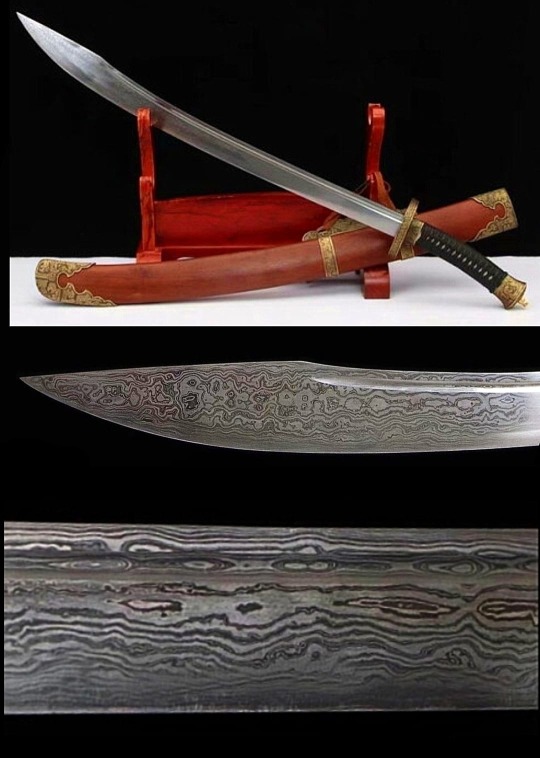Text

Best wishes on this the anniversary of your birth my friend.
Live well and prosper in health, wealth and love .
5 notes
·
View notes
Text
No Death, No Injury, No Illness.
In the early 1960s, during my middle school years, I studied Mei-Hua Changquan (Plum Blossom Long Fist) at the Wu Ti Pang Guoshu School. One day, my master, Yang Baozhen, inquired about my reasons for learning martial arts. My response was likely a typical one about defending my homeland. Master Yang smiled and shared a timeless insight: "In an era dominated by firearms, the relevance of hand-to-hand combat and bladed weapons has waned. Today, martial arts are more akin to a sport, yet we must adhere to three guiding principles: no death, no injury, no illness."
At the time, I merely listened, not fully grasping the depth of his words. After decades of practicing and teaching Kung Fu, I truly understand Master Yang’s wisdom. The goal of martial arts extends beyond mere self-defense; it encompasses preserving one's safety through heightened awareness and avoiding unnecessary confrontation.
Practicing kung fu involves mastering defense techniques, conditioning the mind, and sharpening sensory perceptions to better assess and navigate potential hazards. Additionally, a comprehensive practice of Qigong should incorporate fundamental knowledge of healthcare and traditional Chinese medicine, thereby bolstering immunity and reducing the likelihood of illness.
Avoiding injury entails more than minimizing risks during physical encounters—it also involves practicing martial arts wisely to prevent harm from ignorance or improper technique. Traditional Chinese martial arts are deeply intertwined with broader Chinese cultural practices and represent a holistic approach to wellness and self-preservation.
Thus, the true purpose and criterion for practicing martial arts in modern times are encapsulated in these three objectives: to live without dying, to fight without injury, and to practice without falling ill.
不死,不傷,不病
中學時代我在吳體胖國術舘學習梅花長拳, 有一天,我的師父楊寶珍突然問我,你學拳的目的何在?我的回答打概是保家衛囯之類的陳腔濫調。 楊師笑笑:“進入火器槍炮時代,赤手空拳和冷兵器已成歷史,現今武術已趨向體育化,但要記住這三句,不死,不傷,不病”。 我當時聽聽而已,並沒有完全領會他話裡的深意。。數十年來,從練拳與教拳的生涯裏我終於體會到楊師的智慧: 不死是自衛與明哲保身(戰或逃),練拳不僅是掌握防禦技術更要懂得調整意念和銳化感官知覺,能識別環境而不易陷入危險。而正確練功更應該包括保健養生與中醫的基本常識所以抵抗力強不易生病。不傷不只是如何降低格鬥時受傷機率,但更重要的是練功不可因無知或技術不當而受傷。中國傳統武術與中國文化牢不可分,是全方位的武術文化。不死,不傷,不病是我們在現代練武的目的與準則。
preserving
13 notes
·
View notes
Text

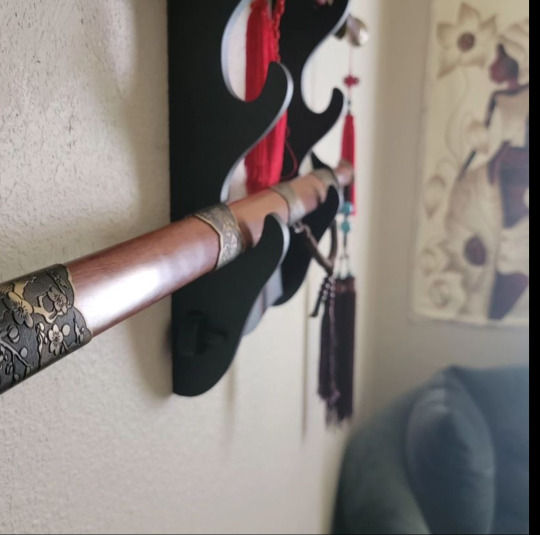


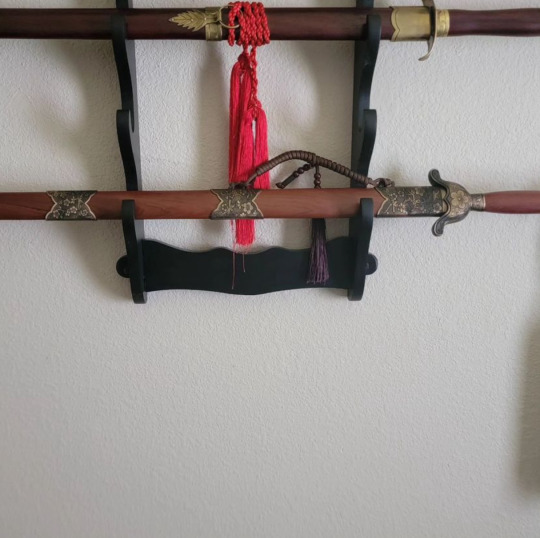
I sent one of my friends a sword, and he is very happy❣️
#sifu kisu#atlab#northern shaolin#northern shaolim#lok#atlab lok#jian#kung fu#piandao#baguazhang#swords#antique swords
13 notes
·
View notes
Text
DISCIPLESHIP
Yup Sut Dai Gee which means (In the back door Skill son) is the Chinese name for Discipleship.
Traditionally the Yup Sut Dai Gee or disciple would represent the school & Sifu in the public eye. If a Disciple behaves badly or sets a bad example it is a poor reflection on the school and the Sifu of that school. Dishonor is then placed on that school through the disciple’s actions. The Yup Sut Dai Gees looks after the school and makes sure that Mo Duk (Martial Virtue) is upheld at all times in the Sifu’s absence. A Disciple is committed to carrying on his or her Sifu’s teachings. Before a student becomes a Yup Sut Dai Gee he must first earn the respect & confidence of the school’s Sifu. It must be proven that the student that may become a disciple is honorable, loyal, reliable and has total faith is the School & his or her Sifu, without question!
If a Yup Moon Dai Gee (student) decides to accept the honor of becoming a Yup Sut Dai Gee or Discipleship he or she then takes on the responsibilities that come with that title.
Many westerners seek discipleship for all the wrong reasons. If you want to become your Sifu’s Disciple, consider your own motivations first. It is not what your Art can do for you, but what you can do for your Art. You do not become a disciple to promote yourself. Quite the opposite, to become a disciple is to abandon your own selfish thoughts and dedicate your practice to others.
You must always put your Art, your Ancestors and your Sifu first.
It becomes your sworn duty to honor your teachers by maintaining your lineage. To become a disciple is like adopting a parent it is not something to be taken lightly. You will swear on oath to be bound to your school & Sifu until death. A warrior’s word is like an arrow, once released; it can never stray until it strikes its target. A Yup Sut Dai Gee also takes on the responsibilities of the school’s growth. If a school does not grow it dies. So the disciple shares this burden with the Sifu. It is said if a Sifu has many Yup Sut Dai Gees, his school will prosper. Because there are many looking out for the well being of the Sifu & school.
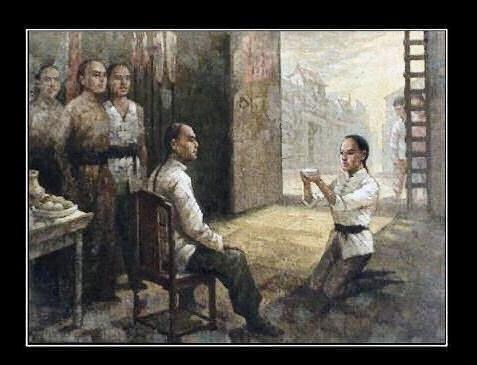
13 notes
·
View notes
Text
New York City, Staten, NY
The first day we will be offering
Northern Shaolim (sic) Bot Bo (shuffle steps/ Open-space fighting combinations.) and second day Pak Kwar (scissor, cut) broad sword.
More details to follow.
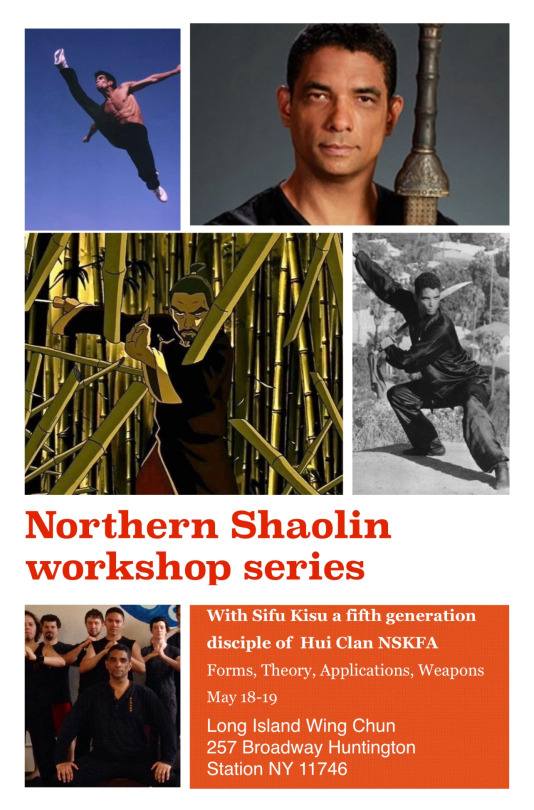
#sifu kisu#lok#atlab#northern shaolin#kung fu#northern shaolim#baguazhang#atlab lok#piandao#jian#new york city#staten island#brooklyn#broadsword
13 notes
·
View notes
Text
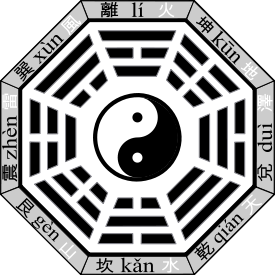
A Brief Discussion of Cheng Style Baguazhang
by Liu Jingru
Wuhun Magazine, 1999 vol. 1 no. 127
translated by Joseph Crandall
Baguazhang is one of the more famous of the traditional Chinese martial arts. It has distinctive practice skill methods and its palm method changes unfathomably. It has a good balanced reputation in the martial community. From the time of Qing Chengfeng (1851-1862), when Mr. Dong Haichuan introduced it until today, it is daily practiced and enjoyed by martial artists in China and overseas.
Mr. Dong Haichuan had many disciples. Yin Fu, Ma Weiqi, Shi Jidong, Song Changrong, Cheng Tinghua, Liang Zhenpo, Liu Fengchun, Zhang Zhankui, Fan Zhiyong, and Liu Baozhen were very famous. In terms of skill, achievements, dedication, and fame, Mr. Yin Fu and Mr. Cheng Tinghua come to the forefront. Although the principles and methods of their skill in Baguazhang was the same, after many years of training and teaching, each one gradually developed their own special style. These have become known as Yin Style Baguazhang and Cheng Style Baguazhang.
Mr. Cheng Tinghua, also called Yingfang was from Shen County in Hebei. He was born in 1848 and died in 1900. He was 52 years old. In Mr. Cheng’s early years he practiced Shuaijiao and Shaolin. As a result of someone’s recommendation, he asked to join Dong Haichuan’s school. He deeply got the pure essence and spirit of Baguazhang. Mr. Cheng was a large and strong man. He had an eyeglasses shop in Beijing. Therefore people all called him “Spiritual Strength Eyeglasses Cheng”.
In 1900, the Eight Countries Allied Armies invaded Beijing. Mr. Cheng wanted to stop a unit of the German army who were bullying the peaceful populace. He engaged the German army unit and was shot and killed.
Mr. Cheng had many students. The most famous were: Feng Junyi, Zhang Yukui, Kan Lingfeng, Li Wenpiao, Zhou Xiang, Zhang Yongde, Sun Lutang, Yang Mingshan, Guo Tongde, Liu Bin, Cheng Yougong, Cheng Youlong, and Cheng Youxin. They all made outstanding contributions to the development of Cheng Style Baguazhang.
Feng Junyi, was good at using the leg method. Men called him “Flying Legs Feng Junyi.” Zhang Yukui, was from a miller’s family. Men called him “Miller Zhang”. Kan Lingfeng men called “Kan Eight”. Zhang Yongde, sold boots. Hedid not know how to write, and often asked people to write letters for him. He never brushed pictures, only boots. Men called him “Boots Zhang.” Zhou Xiang’s face had pockmarks. Men called him “Pockmarks Zhou”. Guo Tongde sold steamed buns to make a living. Men called him “Steamed Buns Guo.” Yang Mingshan first studied with Mr. Cheng to make eyeglasses. Then he asked his teacher if he could also study Bagua. Liu Bin was Mr. Cheng’s youngest disciple. The above men all had very pure skills and were famous in the martial community.
Li Wenbiao, also called Guangpu, was among Cheng Tinghua’s most outstanding students. He was big and tall. His eyes were bright and his spirit was awesome. He was burly with enormous strength. He deeply got the pure understanding of Baguazhang. Li first followed Supervisor of the Military Xu Shichang and went to the Northeast. In Fengtian he was appointed to seek out foreign spies. At that time, many martial artists, like Warlord Li, Spiritual Wrestler Ji Si, Pigua Li Baorong, and Mr. Cheng’s nephew Cheng Yougong in the troops under his command. Later he held office with President Cao Kun in Beijing. Within his troops there were no less than ten of his Baguazhang classmates and some juniors, like Miller Zhang’s student Cui Yugui, Cheng Youlong’s student He Jun, Zhu WenBao’s student Liu Zhigang, and Cheng Tianhua’s student Liu Zitai. When Feng Yuyang rebelled against President Cao Kun, Li was killed in the confusion and looting. Master Li was famous for his depressing palm (ta zhang). No man dared to lightly test him. At that time, the martial community universally praised him.
Mr. Sun Lutang followed Guo Yunshen’s student Li Kuiyuan and studied Xingyi Quan. Then he asked Mr. Cheng Tinghua to teach him Bagua. Later he met Hao Weijin. Because his knowledge was already comparatively deep, he thereupon studied Taijiquan. Mr. Sun purely studied these three styles of martial art. He deeply got every nuance and fused them together. He authored The Real Meaning of Fighting, The Study of Xingyi Quan, The Study of Baguazhang, The Study of Taijiquan, and The Study of Bagua Sword, to be left for future generations. Mr. Sun held a teaching post at the Nanjing Central Kuoshu Institute. He was famous all over, and was one of the great martial arts teachers of his time.
Cheng Yougong, also known as Xiangting, was Mr. Cheng Tinghua’s nephew. When he first practiced Baguazhang, he would get up when the rooster crowed and practice assiduously. One time, in the Eyeglass shop, the disciples were all walking. Eyeglasses Cheng was in the central room drinking tea. Mr. Yougong was in the courtyard practicing the Turning Palms. Mr. Cheng not speak and Yougong was not allowed to stop or pause. In three years Yougong progressed greatly. When he followed Master Li Wenbiao in Fengtian looking for spies, he would practice the palms with a ten pound iron staff. He was never idle. Daily, by himself, would go out and arrest bandits. At that time, the bandits without a doubt all heard his name and lost their courage. He had a position in Headquarters Indoctrination Hall of the Northeast Army of Zhang Zuolin. He taught Baguazhang to Zhang Xueliang.
Cheng Youlong, also called Haiting, was Mr. Cheng Tinghua’s oldest son. When he was young he received Eyeglasses Cheng’s parental teachings. After he lost his father, he practiced his skills even more diligently. He later studied Taijiquan with Mr. Yang Jianhou and blended the two arts to make “Bagua Taiji Quan.” He was fair-skinned, and his nature was forthright and frank. He had a scholar’s air. He was pure in Baguazhang. He was also an expert in drawing and calligraphy. He extensively researched the principles of fighting. He also researched every nuance of the Paired Baguazhang Method and Bagua Meridian Mandarin Duck Axes. He died because he smoked too much. All of his classmates deeply mourned him.
Cheng Youxin, also called Shouting, was Mr. Cheng Tinghua’s second son. When Cheng Tinghua left this world, Youxin was only nine years old. He really never got his father’s true teachings, but learned from Cheng Tinghua’s students. They all gave him instruction and he reached a very high level. As a result of this, the instruction that he received came from many teachers. He did not receive one formal Bagua transmission. Nevertheless his skill caught up to that of his older brother, though it did not surpass it. Mr. Youxin was short and small. He was expert in lower basin stepping. Men called him ‘Cuo Ye’ (Short Uncle). The sum of his studies was his 64 Palms, only he was closefisted in teaching it. Only Mr. Liu Tanfeng got his teachings.
Principle Characteristics of Cheng Style Baguazhang
When practicing, you must walk the circle. Each circle is made up of eight steps with the idea of the feet stepping on the eight trigrams. Walk using the mud treading steps. The inside step moves straight. The outside foot slightly hooks inwards. Walking is done along the edge of the circle and is divided into upper middle and lower basins.
When the hands go out, you must have one palm reach out to the front and one palm defend in the rear. The fingers of both palms point upwards. The thumbs are open wide. The tiger’s mouths are round and push out. The remaining fingers are slightly curved. The fingers can be slightly spread or you can have the fourth and fifth fingers sticking together. The palms face the front and are naturally concave. The form of the back of the palm is like a tile. The heel of the palm pushes out. The palm strength is vigorous. It is called “Dragon Claw Palm.” The basic palm formation above is from Mr. Dong Haichuan.
The steps in Yin Style Baguazhang are small, lively, and tend towards a natural step. In Cheng Style Baguazhang, the steps are slightly larger. They change and transform at many points. Cheng Style Baguazhang is especially good at using large swing and hook steps. This is because Cheng Tinghua practiced Shuaijiao in his early days. The gripping and throwing method was blended into his Baguazhang. The swing step and hook step are truly transformed to cause tripping.
The outgoing hand in Yin Style Baguazhang is direct, with particular attention paid to suddenness, crispness, firmness, quickness, and abundant springy shaking strength. Men call it hard palm. Cheng Style Baguazhang pays attention to the interplay of hard and soft, with a lot of spiraling energy. It often has touching, sticking, continuously following, neutralizing, issuing and releasing, all coordinated together.
Cheng Style Baguazhang mainly uses hidden legs. It is very good at using the tips of the foot. When doing piercing palm, the heart of the palm faces upwards. The five fingers point to the front. The pierce goes out under the front arm. The palm method has cloud, thrust between, pierce, and strike... only it mainly uses push, uphold, pull aside, lead, parry, hook, split and advance.
Cheng Style Baguazhang is very good at holding three forms concurrently: Walking like a dragon. Turning like a monkey. Changing postures like an eagle. Sometimes it is tight and compact. Sometimes it is big and open. It is nimble, circular, and lively. It stretches out everywhere. It is especially good at twisting, wrapping, drilling, and overturning. The turning palms are like twisting rope.
The Palm Method Routines of Cheng Style Baguazhang
Mr. Cheng Tinghua had many students. For the most part they all had skill before they sought instruction from the master. Some of the students only studied a few palms before they left the teacher. They gained considerable fame among their contemporaries. Consequently by the time we get to the fourth generation, the names of the practice methods of the basic eight palms, eight big palms and their routines are no longer the same. Cheng Youlong’s student Sun Xikun wrote Genuine Transmissions of Baguazhang. In it his Eight Big Palms are: Single Change Palm, Double Change Palm, Flowing Posture Palm, Three Piercing Palms, Grinding Body Palm, Overturning Body Palm, and Returning Body Palm. Mr. Cheng Youxin was Cheng Youlong’s little brother. His Eight Big Palms do not have Three Piercing Palms, but instead have Turning Body Palm. My teacher, Luo Xingwu, asked Cheng Yougong about this business. Mr. Cheng Yougong said, “The Eight Big Palms must contain Turning Body Palm, and do not have Three Piercing Palms. Maybe Sun Xikun only had seven palms. Maybe he kept one palm secret and used Three Piercing Palms as a substitute.” Saying this, he immediately demonstrated Turning Body Palm. Therefore my teacher’s Turning Body Palm is from Cheng Yougong’s tradition and not Li Wenbiao’s teachings.
The Palm Method Routines of Cheng Style Baguazhang are:
Basic Eight Palms: Fierce Tiger Leaves the Mountain, Big Peng Spreads it Wings, Lion Opens it Big Mouth, White Ape Offers the Peach, Embrace the Moon to the Center of the Chest, Black Bear Searching Arms, Point to Heaven Insert to Ground, and Green Dragon Searching Claws.
Each palm has its own special energy and strength. Each palm has its own functional method. These are not just sections of Bagua’s palm method, but they are also the foundation of the Eight Big Palms and the 64 Palms. Therefore they are called the Basic Palms.
The Eight Big Palms: Single Change Palm, Double Change Palm, Flowing Posture Palm, Behind the Body Palm, Turning Body Palm, Grinding Body Palm, Overturning Body Palm, and Returning Body Palm.
The Eight Big Palms are not only the core routines for practicing Baguazhang skills, but they each also possess eight distinctive striking methods.
Single Change Palm is the outgoing hand already striking. All of a sudden it appears and it is over. Double Change Palm is a continuation of Single Change Palm, doing two or three strikes in a row. Flowing Posture Palm goes in the same direction as the opponent’s incoming hand. The energy and strength flow with the posture and yet strike. Behind the Body Palm goes contrary to the opponent’s incoming hand’s direction, contrary to energy and strength and yet strike. Turning Body Palm is turning to the left and right in front of the enemy. It has the left rotating and right turning striking methods. Grinding Body Palm uses toeing in and toeing out stepping in place in front of the enemy. It uses close-in striking. Overturning Body Palm uses suddenly turning over the body to strike in adverse circumstances. Returning Body Palm uses striking and then immediately walking away. Suddenly you turn back and strike again. Thereby defeating your opponent by a surprise move. Thus, the saying: “If you have Single , then you must have Double. If you have Flowing then you must have Behind. Turning Body Palm rotates left and turns right. Grinding Body Palm is not far from the enemy’s body. Overturning Body Palm is like the overturning body of a python, it defeats ones opponent by a surprise move. Returning Body Palm strikes and then walks away, walks and also returns. It is like a sparrowhawk turning back its head to grips its body.”
64 Palms: Though not included in the Eight Big Palms, each palm again adds seven palms. Together they are called Single Change Eight Palms. These are eight kinds strikes having the outgoing hand striking suddenly and being suddenly done. Double Change Eight Palms continues from Single Change Palm. It has eight types of strikes done two or three times in succession. Flowing Posture Eight Palms has eight types of strikes moving in the same direction as the opponent’s incoming hand’s direction. Behind the Body Eight Palms has eight types of strikes that go contrary to the opponent’s incoming hand’s direction, energy, and strength. Turning Body Eight Palms has eight types of strikes done now to the left and now to the right in front of the enemy. Grinding Body Eight Palms has eight types of strikes toeing in and toeing out in place close to the body in front of the enemy. Overturning Body Eight Palms has eight types of suddenly overturning the body to strike in adverse circumstances to defeat the opponent by a surprise move. Returning Body Eight Palms has eight types of striking and walking away, walking and also returning to strike.
The 64 Palms is a complete summation of the practice methods that Master Cheng Youxin learned from Master Cheng Tinghua and all of his classmates. truly is second generation, third generation and master Cheng Youxin’s 50 years painstaking training. By practicing the 64 Palms, not only can you strengthen your skill, but you can enrich the palm methods, and it can even help you to grasp the skills and essentials of Baguazhang.
Swimming Body Connected Palms: Swimming Body Connected Palms consists of the Basic Palms, Eight Big Palms, and the 64 Palms reorganized into connected routines. It can be used for participating in competitions and performances. It provides the practitioner with aesthetic grace. By practicing it you will strengthen your awareness of attack and defense. It will add many more changes to the palm method. The body method will become more agile. The stepping method will become still more ingenious. The skill will become richer. By going through with the training, the whole body, each muscle, joint, and organ, all parts of each physiological system get trained. It dispels disease, strengthens the body, and is a means of prolonging life.
Cheng Style Baguazhang Weapons Routines
Master Dong Haichuan was very good at the saber method. Master Dong’s epitaph says: “Dong’s hands went inches past his knees, therefore fists and palms many leave the man unexpected, all difficult defend against.” The length of the body of the Bagua saber is 4 feet 2 inches. Add this to the fact that Master Dong’s hands reached past his knees, we are approaching seven feet of length and beyond. We can infer that Master Dong, when he had a saber in his hand, was an impressive and extraordinary sight to behold. Therefore all of Master Dong’s students were good at the Bagua saber method. Cheng Style Baguazhang has in it Rolling Hand Saber, Point the Road Saber, Crowd Blocking Saber, and using the principles of walking and turning is Turning Saber.
Cheng Style Baguazhang has the sword method in it. Sun Lutang wrote a book A Study of Bagua Sword. Master Sun Xikun also has a sword method in his True Transmission of Baguazhang. The sword’s style and functional method are similar to the Bagua Saber. The Bagua sword has two edges, and besides the saber-like methods, there are the many uses of the sword’s point.
There are spear methods in Cheng Style Baguazhang, many of which are from the teachings of Big Spear Liu Dekuan. After Master Cheng Tinghua died, Big Spear Liu was the acting teacher and controlled the junior apprentices. He did his best to teach them, and give guidance and support to the less advanced. His transmission has Fighting Body Spear, Eight Spear, Black and White Sparrowhawk, Small Sparrowhawk, the method of the halberd, qinna methods and the straight line practice of 64 Hands.
24 notes
·
View notes
Text
4 notes
·
View notes
Text

Nobu Isere was a direct student of Morihei Ueshiba and shared many secrets and routines with me.
My old friend I miss you, you were so wise and so strong.
rest in peace.
#aikido#sifu kisu#atlab#lok#northern shaolin#northern shaolim#jian#kung fu#atlab lok#piandao#baguazhang
15 notes
·
View notes
Text
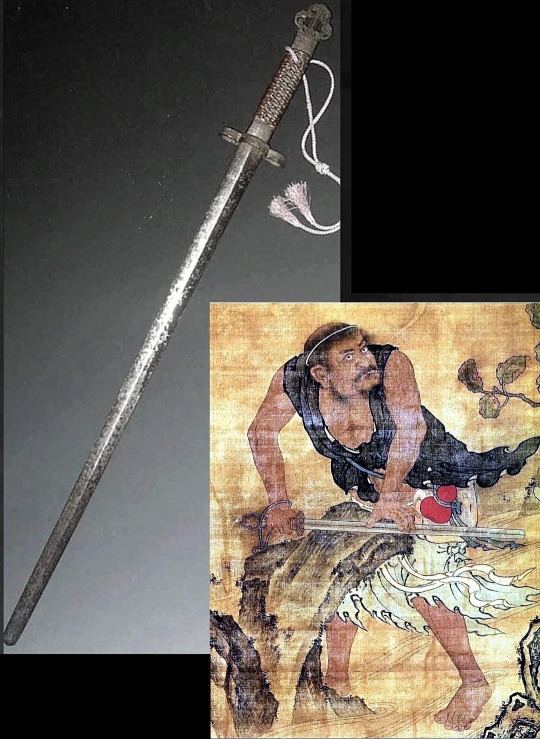
Ming painting of a Taoist mystic with a Jian equipped with disk guard and openwork pommel. Wrist loop tassel is also shown.
Next to it is an original Ming Jian with iron fittings consisting of the 4 lobe disk guard and trilobe openwork pommel.
#ming dynasty#jian#sifu kisu#lok#atlab#northern shaolin#northern shaolim#atlab lok#baguazhang#piandao#kung fu
23 notes
·
View notes





